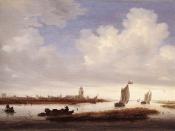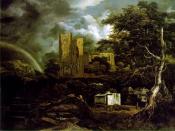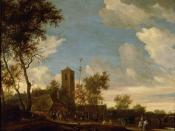Ruisdael's painting, Wheatfields, depicts a Dutch rural panoramic landscape. The medium used is oil on canvas and the actual size of the composition is very large, which adds to the grandeur created through his techniques of depiction. Ruisdael painted Wheatfields in c. 1670 in the later years of his life.
The organisation of Ruisdael's pictorial space encourages the spectator to feel small. The mass of the rustic, realistic natural environment is encumbering, with the small figures of people and animals. The angle of the spectator's vision is directly central to the picture plane, which allows us an expansive view to both the left and right. To the far left we can see the sea, on which boats are sailing. From the middle to the right we see intricately painted trees and an old brick building through the trees. Our line of vision follows an old dirt track which hedges, logs and blades of grass line before meeting the expansive wheat fields.
The line of perspective is approximately two thirds from the top of the picture in which Ruisdael devotes the upper end of his picture to his depiction of the sky.
Ruisdael's use of tone and colour is wide-ranging and natural, the bright blues and whites of the sky contrast and complement the yellow and orange hues of the fields below them. The merging colours are only interrupted by the browns and greens of the trees. The light source is sunlight - broken only by the mass of clouds, which serve to provide shade to the landscape below.
The overall effect served by this landscape is one of overwhelming natural bounty. The diminutive human and animal figures emphasise the symbolic them of vanitas. The landscape with its brown hues suggests an autumn setting, perhaps implying that even...



Ruisdael
Well observed! Just one thing - If it was the autumn, the wheat would have been haevested. I like this painting, particularly the way the figures are so small emphasising that they are part of this landscape, not additional.
3 out of 3 people found this comment useful.